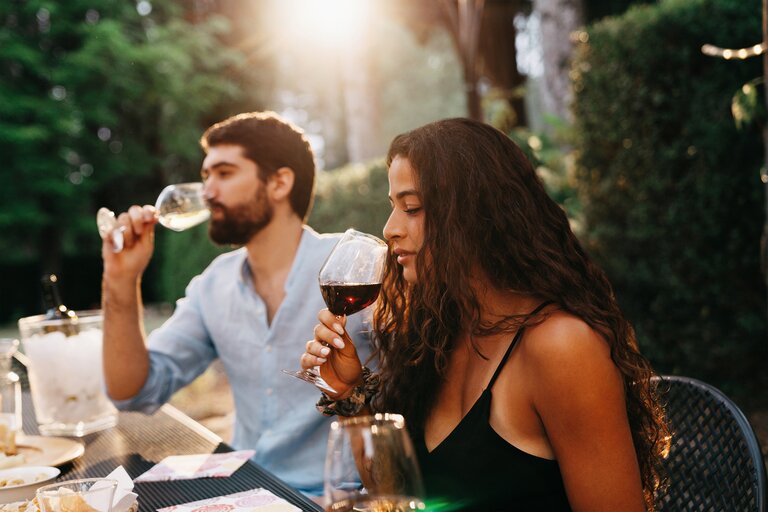Wine Tasting Flights at Home: Complete Guide
Why Host Wine Flights at Home?
August 29, 2025

Your dining table becomes a stage for discovery when you master the art of hosting wine tastings at home. Whether gathering friends for an educational evening or connecting virtually with loved ones across the country, comparative wine tasting flights transform casual sipping into an enlightening journey through the world of wine.
Home wine tastings create an environment where genuine discovery flourishes. Guests feel free to ask questions, share honest opinions, and learn at their own pace without the formality of professional tastings. This relaxed atmosphere often leads to more meaningful discussions about wine preferences.
Types of Wine Flights Perfect for Home
Horizontal Flights
Compare wines from the same vintage across different producers or regions. Taste 2021 Cabernet Sauvignons from Paso Robles, Napa Valley, and Bordeaux side by side to see how terroir shapes identical grapes into unique expressions.
Vertical Flights
Follow one wine through multiple vintages to witness evolution over time. This works beautifully with age-worthy wines like JUSTIN ISOSCELES, where comparing current releases with library vintages reveals how patience creates complexity.
Varietal Flights
Understand different grape varieties by comparing Cabernet Sauvignon, Merlot, and Cabernet Franc to recognize each grape’s distinctive characteristics and understand blending decisions.
Regional Flights
Focus on one grape from different areas. Try Pinot Noirs from Paso Robles, Burgundy, and Marlborough to highlight how climate and soil influence the final product.
Quality Progression Flights
Sample wines from a single producer at different price points. Start with JUSTIN Cabernet Sauvignon, progress to Reserve Cabernet, and culminate with ISOSCELES to understand how vineyard selection justifies price differences.
The Art of Wine Evaluation
Master the Five S’s of wine tasting:
- See – Hold your glass against a white background to observe color and clarity. Young reds show purple edges while aged wines develop brick tones.
- Swirl – Gently rotate to release aromas. Watch “legs” form on the glass to gauge alcohol content and body.
- Sniff – Take short sniffs to identify fruit aromas, fermentation characteristics, and aging notes. First impressions often prove most accurate.
- Sip – Let wine coat your palate. Notice the entry, midpalate, and finish. Consider how fruit, acidity, tannins, and alcohol create balance.
- Savor – Reflect on the complete experience. Does the wine deliver on its aromatic promise? Would you purchase it again?
How to Set Up a Wine Tasting at Home
Setting up a successful home wine tasting begins with understanding what makes wine flights special. Unlike casual wine drinking, flights involve tasting three to six carefully selected wines side by side, allowing your palate to detect subtle differences that might otherwise go unnoticed. This comparative approach transforms wine from a simple beverage into a subject worthy of exploration.
The beauty of hosting wine flights at home lies in complete control over the experience. You choose the theme, set the pace, and create an atmosphere that encourages both learning and enjoyment. Start by selecting a clear theme – perhaps exploring different regions, comparing grape varieties or showcasing how wines evolve with age. This focus provides structure and helps guests understand what they’re comparing.
Hosting a Memorable Wine Flight Evening
Send invitations two to three weeks ahead for groups of four to eight people. One bottle provides proper two-ounce tasting portions for six people.
Evening Timeline:
- Welcome with water and light snacks
- Brief theme introduction
- First flight of wines
- Break with palate cleansers
- Second flight if applicable
- Reveal wines if blind tasting
- Enjoy remaining wine with food
Blind tasting prevents label bias – cover bottles or decant into numbered carafes, revealing identities only after everyone forms opinions. Encourage all observations without judgment; the goal is exploration, not competition.
Perfect Food Pairings for Your Home Wine Flight
During formal evaluation, stick to neutral palate cleansers. Save assertive foods for after tasting.
For Red Wine Flights:
- Aged cheeses (Gouda, sharp cheddar)
- Charcuterie and cured meats
- Dark chocolate (65 percent cocoa minimum)
- Dried fruits and Marcona almonds
For White Wine Flights:
- Fresh cheeses (goat cheese, burrata)
- Smoked salmon or light seafood
- Fresh fruits (apples, pears)
- Mild olives and crackers
Creating Your Perfect Home Tasting Setup
Essential Supplies:
- Identical glasses for each wine
- White tablecloth for color assessment
- Good lighting (natural or bright white)
- Water and plain crackers
- Notebooks for tasting notes
- Temperature control (ice buckets or wine fridge)
Serving Temperatures:
- Sparkling wines: 40 to 45 degrees Fahrenheit
- Light whites: 45 to 50 degrees
- Full-bodied whites: 50 to 55 degrees
- Light reds: 55 to 60 degrees
- Full-bodied reds: 60 to 65 degrees
Remember – wines warm quickly once poured, so start slightly cool. Remove competing aromas like scented candles or cooking smells that might interfere with wine aromatics.
Virtual Wine Tastings With JUSTIN
Can’t gather in person? JUSTIN's virtual tasting program brings our Wine Educators to your home via video conference, sharing insider stories about vintages and winemaking decisions while you taste along.
Keys to Virtual Success:
- Ship wines two weeks ahead or provide a detailed shopping list
- Test technology beforehand
- Position camera to show face and wine setup
- Use good lighting for color assessment
- Send digital tasting sheets in advance
- Keep sessions to 60 to 90 minutes
JUSTIN’s diverse portfolio creates exceptional home tasting opportunities. Our Bordeaux Journey showcases how different varieties contribute to complex blends. Start with JUSTIN Cabernet Sauvignon, taste Cabernet Franc for its aromatic contribution, then experience how ISOSCELES marries multiple varieties into something greater.